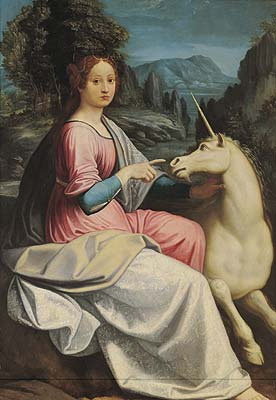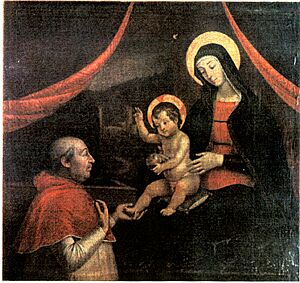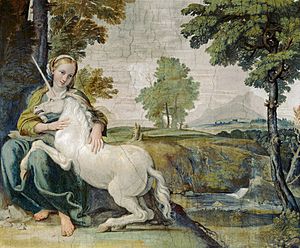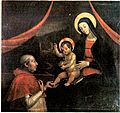Giulia Farnese facts for kids
Quick facts for kids
Donna
Giulia Farnese
|
|
|---|---|

Lady with a Unicorn by Luca Longhi, 1535-1540 possibly a portrait of Giulia Farnese
|
|
| Governor at Carbognano | |
| In office 1506–1522 |
|
| Monarch | Julius II (1506-1513) Leo X (1513-1521) Adrian VI (1521-1522) |
| Preceded by | Orsino Orsini |
| Personal details | |
| Pronunciation | dʒuˈlia farneze |
| Born |
Giulia Farnese
1474 Canino, Papal States |
| Died | March 23, 1524 (aged 49–50) Rome, Papal States |
| Spouses |
Orsino Orsini
(m. 1489; died 1500)Giovanni Capece Bozzuto di Afragola |
| Relations | Pope Alexander VI (lover) |
| Children | Laura Orsini (fatherhood disputed) |
| Parents | Pier Luigi Farnese Giovanna Caetani |
Giulia Farnese (1474 – 23 March 1524) was an Italian noblewoman from a powerful family. She was known as Giulia la bella, which means "Julia the beautiful" in Italian. Giulia was a member of the important Farnese family, who were leaders in the Italian regions of Parma and Piacenza.
Giulia became connected with Pope Alexander VI. This connection helped her brother, Alessandro, become a cardinal. Later in her life, Giulia spent many years managing the castle of Carbognano. She passed away in 1524 in Rome.
People who knew her described her beauty. Lorenzo Pucci called her "most lovely to behold." Cesare Borgia, Pope Alexander VI's son, said she had "dark colouring, black eyes, round face and a particular ardor."
Contents
Biography
Family and Early Life
Giulia Farnese was born in Canino, a town in the Papal States. Her parents were Pier Luigi Farnese and Giovanna Caetani. The Caetani family was also very old and important. One of their ancestors was Pope Boniface VIII (1294–1303).
Giulia had four siblings. Her oldest brother, Alessandro, chose a career in the church. He later became Pope Paul III. Her other brothers were Bartolomeo and Angelo. She also had a sister named Girolama. When Giulia was fourteen, her mother sent her to Rome. This was so she could finish her education and join the important families of Rome.
Marriage and Connections

On May 21, 1489, Giulia married Orsino Orsini in Rome. Her family provided a large dowry for the marriage. Orsino was related to Cardinal Rodrigo Borgia, who later became Pope Alexander VI.
Giulia became close to Cardinal Rodrigo Borgia. This connection was very helpful for her family. For example, Giulia helped her brother Alessandro become a Cardinal in 1493. This was a very important position in the church. She also helped him with money, allowing him to buy a palace in Rome.
In 1492, Giulia had a daughter named Laura. It is not fully clear who Laura's father was. In 1494, Giulia traveled to Capodimonte to be with her brother Angelo, who was very ill. She stayed there even after he passed away. On her way back to Rome, she was captured by a French captain. The Pope paid a large sum of money to ensure her safe return to Rome.
Giulia remained close to the Pope until around 1499 or 1500. After this time, her close connection with him ended. Her husband, Orsino, also passed away in 1500. Giulia then moved to Carbognano, a town near Rome. The castle in Carbognano had been given to Orsino by Pope Alexander VI.
Later Life and Death

Giulia returned to Rome in 1505 for her daughter Laura's wedding. Laura married Niccolò Franciotti della Rovere. Niccolò was related to the Pope at that time, Pope Julius II.
After being a widow for some years, Giulia married Baron Giovanni Capece Bozzuto di Afragola. In 1506, Giulia became the governor of Carbognano. She lived in the castle's main building. Records from the castle show that Giulia was a strong and effective leader. She stayed in Carbognano until 1522, then she moved back to Rome.
In early 1524, Giulia felt that she was close to death. She wrote her will on March 14th in her room in Rome. Giulia passed away there, at the age of 50, in the house of her brother, Cardinal Alessandro. The exact cause of her death is not known. Ten years later, her brother Alessandro became Pope Paul III. Giulia's daughter, Laura, and her husband Niccolò had two children, a son named Giulio and a daughter named Lavinia. They inherited the family's possessions.
Images for kids
See also
 In Spanish: Julia Farnesio para niños
In Spanish: Julia Farnesio para niños




